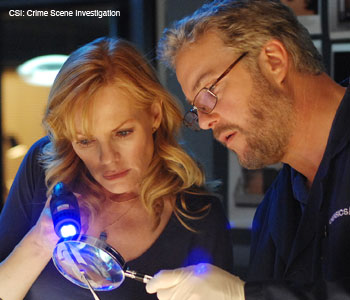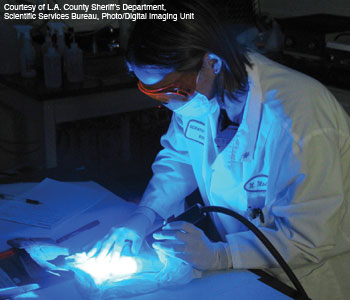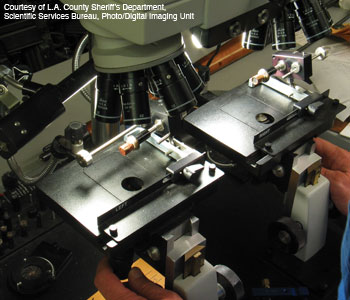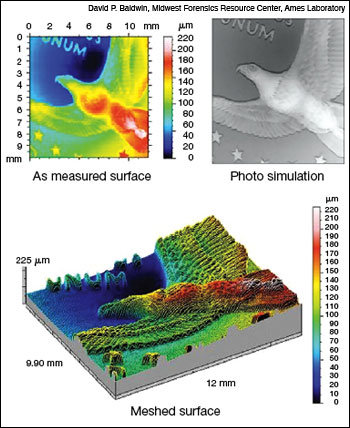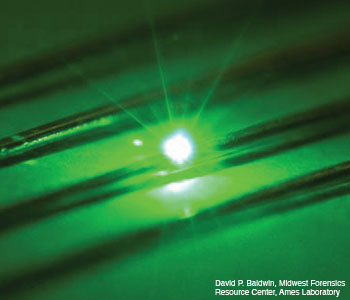On a darkened Hollywood set, two svelte actors wearing orange goggles shine a beam of white light onto walls, floors and furniture. One exclaims, “I’ve found something!” The camera zooms in on a fluorescent blue handprint. Meanwhile, another actor places a piece of unidentifiable evidence inside a clear plastic box. A bright red beam strikes it and turns some of it into a smoky cloud. The actor looks at a nearby computer screen and announces, “That’s a match!” These scenarios may strike some researchers as corny, but the technology behind them is real. (Granted, lasers that zap evidence samples may get some enhancement from the special-effects department.) New optical techniques, many involving lasers, are joining DNA analysis in the pantheon of scientific weapons for tracking down criminals and exonerating the innocent. But such devices are currently limited to the minority of forensic laboratories that can afford such instruments. Virtually all crime labs are government entities, which operate under the fundamental mantra “faster, better, cheaper,” according to Barry A.J. Fisher, director of the Los Angeles County Sheriff’s Department crime lab. A crime lab examines virtually any form of evidence associated with criminal activity, Fisher said. Whichever techniques that crime lab workers use must pass muster in a courtroom eventually. Thus, forensic specialists like their equipment to be cutting-edge, but not so novel that there may be lingering questions about its effectiveness, Fisher said. Crime labs tend to be somewhat conservative about their core tools while remaining on the lookout for new technologies. Many challenges in forensic science have to do with determining the likelihood that two fragments of evidence came from the same place or were part of the same object, said David P. Baldwin, director of the Environmental and Protection Sciences Center at the Energy Department’s Ames Laboratory in Ames, Iowa. “People have come to expect the kind of certainty you get from DNA analysis,” Baldwin said. “That’s not possible in some cases.” Raising those expectations over the past few years has been a wave of prime-time television dramas that depict crime lab investigators as brilliant crime-solvers with an arsenal of high-tech instruments. “The forensics are essentially another character in the show,” said Rich Catalani, executive story editor for the CBS show CSI: Crime Scene Investigation, and a former ballistics analyst in Fisher’s lab. One of the good things is that the popularity of CSI makes manufacturers of these cool new instruments eager to get their devices on the TV show. The reality is that the fictitious Las Vegas forensic crew has more state-of-the-art equipment than many actual crime labs, Catalani said.
Photographing the crime sceneOut in the field, once a crime has been discovered, an investigator’s essential task is detection: finding a stain, a fingerprint, a loose fiber or other physical evidence. The investigator must separate crime-related items from the normal detritus of human activity. Max M. Houck, director of the Forensic Science Initiative at West Virginia University, called it “very short-term archaeology.” Historically, forensic investigators have used film-based photography for wide-angle and close-up images of crime scenes. But in recent years many have made the switch to digital photography, Fisher said. By doing so, they have had to deal with the persistent popular belief that digital images are more easily manipulated than film, and therefore less trustworthy in a criminal trial. The truth is that film and digital images are equally vulnerable. “There’s really nothing in PhotoShop that you can’t do in a darkroom,” Houck said. “It’s more perception than reality.” Digital photos of the crime scene are evidence, and, as such, forensic scientists must take steps to ensure they don’t get tampered with, such as using tracking software to preserve the digital chain of custody. The real issues with digital imaging are resolution and storage, Houck said. Digital photography still lags far behind film in the amount of detail that can be resolved. One megapixel is about as good as a Polaroid instant-camera image. “You really need to have more than 10 megapixels before you begin to approach film,” Houck said. “If you’re trying to analyze grain boundaries in some sort of material, you really need the resolution that film provides.” Also, storage media will undoubtedly change over the years; even today, computers are shipping without the once-ubiquitous floppy drives. Within the realm of traditional photography, though, archivists can still print images from 100-year-old negatives, or even from daguerreotypes. “When you realize that, you should be at least a little concerned about the longevity of digital images and their readability at some future date, which is particularly important in the court system,” Houck said. Law enforcement agencies need some assurance that relevant images will be accessible many years down the road—not just for cold cases, but also for death penalty appeals, Fisher said. |
Illuminating potential evidenceOne of the bigger challenges for forensic science, according to Houck, is that, unlike in a standard laboratory, where sampling is carefully planned in advance, forensic technicians have to play the hand they’ve been dealt. Finding potential evidence is the critical first step. The alternate light source (ALS) is a handheld device that contains a xenon, tungsten or halogen lamp and tunable filters; investigators adjust the emitted wavelength to highlight different things. These commercially available instruments help investigators find bits of trace evidence, such as tiny clothing fibers that the perpetrator may have left at the scene. Many ALS systems include goggles with tinted lenses that are paired with the filter passbands. Semen stains, illuminated at 450 nm, “pop like a pale blue fluorescence,” Catalani said. Urine stains will look yellow-green. Blood will absorb the blue light and thus look black. Teeth and bone fragments will glow with an eerie pale white/blue. As lasers have shed weight and cost over the years, crime scene investigators have taken them into the field too. The first generation of such devices consisted of water-cooled argon lasers that required three-phase power and were mostly confined to the forensic lab, said Andrew Masters, marketing director for Coherent Inc. of Santa Clara, Calif. About five years ago, Coherent introduced a second-generation diode-pumped solid-state laser called the Incriminator, Masters said. It used recirculating cooling water and standard electrical power, but still cost approximately $100,000. Last year, the company debuted the TracER, a self-contained 6-W, 532-nm laser in a portable unit with a rechargeable battery. The light source has a bandwidth of 1 nm instead of 50 nm for a typical ALS, making more green light available for better depth of field when photographing fingerprints on a curved piece of evidence, Masters said. According to Catalani, a device called the NarTest made its CSI debut in the episode aired on January 25. The NarTest NTX 2000 is a tabletop-sized infrared spectrometer that is preset to look for the spectral fluorescence signatures of the four most commonly abused illicit drugs: methamphetamine, cocaine, heroin and marijuana. The manufacturer, NarTest Technologies of Morrisville, N.C., claims that the instrument can detect the presence of any of the four drugs in 5-10 minutes. Together, the machine and personnel training will cost a law enforcement agency about $40,000.
Back at the crime labManufacturers are willing to lend CSI Productions new “toys” for inside the lab, too, Catalani said. For example, laser ablation—in which an infrared laser boils off a small amount of a solid surface for analysis in a mass spectrometer—provides another opportunity for one of those “cool CSI shots.” The special-effects people show a red laser beam vaporizing the item in question inside a clear box, whereas in real life the infrared laser—producing as much as 109 W/cm3 of energy—usually operates inside an opaque chamber. Baldwin’s group at Ames Laboratory, in collaboration with researchers at Lawrence Berkeley National Laboratory, has been studying forensic applications, such as identification of solid materials, for laser ablation. One traditional method of identifying an unknown solid involves taking several milligrams of material, dissolving it in acid and spraying it into a stream of argon in a plasma system. In that old technology, it’s difficult to analyze tiny samples, and the process introduces other chemicals into the mix. “With laser ablation, if you can see it, you can shoot it and get data out of it,” said Glenn A. Fox of Lawrence Livermore National Laboratory. Laser ablation offers less likelihood of contaminating the sample, and of course it saves a lot of time, Baldwin said. One limitation is that sometimes technicians don’t know whether they are removing a sample that truly represents the bulk of the material. Also, laser ablation is more suited to metals and elemental analysis because the high energies involved would destroy molecular bonds. Future laser-ablation systems will make use of far-ultraviolet and femtosecond lasers, although the latter are still very expensive, Baldwin said. Ablated particles that are too big won’t be fully digested for the mass spectrometer, and shorter-pulse and UV lasers make smaller particles come out of the ablation process. Fourier-transform infrared (FTIR) spectroscopy has melded with microscopy to analyze the chemical composition of small fragments of evidence, down to sub-millimeter field sizes. In his previous lab career, Catalani put suspected drug samples inside potassium bromide pellets in order to perform transmission FTIR spectroscopy. Today, FTIR microscopy permits reflectance FTIR spectroscopy with virtually no need for sample preparation. FTIR microscopy can determine the chemical composition of each layer in a paint chip—which gives investigators higher confidence that two paint chips might have come from the same source, Baldwin said. Multispectral and hyperspectral imaging techniques use multiple emission spectra under different lighting conditions in order to distinguish subtle differences, such as whether all the ink on a check came from the same pen. Baldwin said that these techniques also could be used on fibers, paint samples and other chemicals. These techniques are fairly common in remote sensing, but are new to forensics. Laser microdissection systems, which consist of a laser mounted to a microscope, allow laboratory workers to separate different kinds of cells in a tissue sample. Such techniques can help distinguish the sperm cells from multiple rapists and analyze old samples from cold cases, Baldwin said. The “rape kit” that is mentioned on TV crime shows collects a mix of epithelial cells from the female as well as sperm cells from the male. The mix of DNA from the two genders makes it difficult to get a sure match from the rape kit to a suspect’s DNA. Chemical treatments can wash out the female cells, but this limits the sensitivity of the DNA test. |
The laboratory technician can smear a sample of vaginal fluid onto a glass slide, mounted upside down, and focus the laser microdissection device on the individual sperm heads and female epithelial cells. The laser, positioned underneath the slide, cuts around the sperm heads, which drop into a collection tube to produce a relatively pure sample from the male suspect. “To be able to go into a mixture of cells and say ‘I want that one’ is a great advance,” Baldwin said. With laser microdissection, a skilled forensic technician can obtain a DNA profile from a single-digit number of cells. That kind of sensitivity was unavailable 10 years ago. In spectroscopy, multifunctional devices and microfluidic technology are the trends, Houck said. The latter uses a fabricated, disposable chip that works through surface tension pressures to flow into analytical wells. The analyst can do a standard dilution and have the chip analyze the sample without a lot of prep work. The prototype chips that Houck has seen are about the size of a business card, which makes them easy to handle and store. Microfluidic chips are still in the research phase but close to being deployed commercially, Houck said. Suzanne Bell, assistant professor of chemistry at West Virginia University, has led many of these efforts. Most forensic scientists aren’t yet applying multivariate statistical analysis, but Baldwin said he is trying to promote that mathematical technique for examining minor differences between spectra to see if they are statistically significant. Today, a commercially available device called a profilometer can generate 3D maps of surfaces in order to compare the surfaces using statistical analysis, Baldwin said. The profilometer uses either a diamond stylus or laser to measure the topography of surfaces with height variations in the sub-micron region. The technique can be applied to comparisons of burglary-tool marks and bullet striations, which have been done using traditional microscopes and photography. “You can have a picture of El Capitan out on Yosemite, but unless you’ve been there or have a topographical map, you don’t know how big it is,” Baldwin said. But Houck believes that the push toward three-dimensional data is unwarranted until scientists know how to do proper statistical analyses. “Too many people ignore a good microscope,” he said.
Cost, standards and legal considerationsSome officials want to move as much of the forensic analysis out to the field as possible, Houck said. However, that would raise the possibility that police officers and firefighters who are not scientists will be asked to do analytical testing on top of their other investigative duties. “The training of a law enforcement officer is not the same as a scientist,” Houck said. “It’s like asking the lawyers to analyze things in the laboratory.” It’s not that forensic scientists are not interested in the latest and greatest, Fisher said. Rather, the major issue is whether the technology answers their questions. “It never pays to go out and buy multi-hundred-thousand-dollar [equipment] when we only use it a few times.” Also, because of the cost and training involved, new techniques aren’t going to enter the crime lab unless they can become a lab workhorse. Even in a big crime lab, 90 percent of the work consists of blood alcohol tests, drug analysis and DNA rape kits. Few, if any, labs will own a laser ablation system, Baldwin said. It could perform useful science, but if a lab doesn’t use a device often, it’s not worth the investment. Occasional high-tech tests can be outsourced to a larger laboratory. Fox, who served as director of Livermore’s Forensic Science Center before a recent promotion to deputy associate director for chemistry, said that the lab tries to assist local communities despite its heavy focus on forensic analysis of potential weapons of mass destruction. Most state and local crime labs are accredited, Baldwin said, and there are standards for techniques: published work and laboratory validation of people and instruments. Good labs have set standard quality assurance techniques. The Laboratory Accreditation Board of the American Society of Crime Laboratory Directors accredits labs and has developed a new standard based on ISO 17025. Of course, the question of whether a piece of evidence or expert opinion is acceptable in a particular case is ultimately up to the judge, Baldwin said. New science “should be thought out and subjected to publication before somebody’s life or liberty is in the balance.” One of the main differences between forensics and other types of science is that kind of pressure from the courts, Houck said. Science is about innovation and novelty—things that reinforce some risk-taking—whereas the courts are antithetical to risk-taking. The conservative nature of the court system limits what can or cannot be an acceptable forensic analysis, Houck said. The first person to do a particular type of analysis or scientific test on potential evidence is probably not going to get the results admitted in court. The admissibility of a forensic analysis depends on a number of factors, which center on how robust the method is and whether it has been peer-reviewed. Since 1993, the criteria outlined in the U.S. Supreme Court case Daubert v. Merrill Dow Pharmaceuticals are used to judge the relevancy and reliability of expert testimony and testing. Houck and Fisher agree that much Ph.D.-level work in forensic science remains to be done. They and their colleagues also suggest that companies specializing in optical technologies for categorizing materials take an interest in the realm of forensic science. Several thousand crime labs around the country would be a rich potential market for such tools. [ Patricia Daukantas is the senior writer/editor of Optics & Photonics News. ]
[ References and Resources ] >> D.A. Stoney. “Optical Methods and Forensic Science,” Opt. Photon. News 9(4), 23 (April 1998). |

